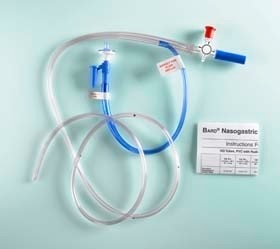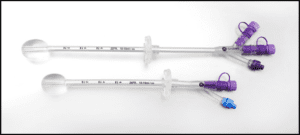Few illnesses such as post major surgeries, oral surgeries and critical illnesses prohibit taking food orally. In these situations, the nutritional support for the patients is given externally. Enteral feeding tubes are medical devices that provide nutrition directly into the gastrointestinal system of the patients. They are typically employed when the patient’s oral intake is restricted and/ or inadequate or compromised.
Enteral feeding tubes are classified as nasogastric tubes (NG tubes), nasoenteric tubes, gastrostomy tubes (G-tubes), and jejunostomy tubes (J-tubes). The type of tube used is determined by several considerations, including the patient’s condition, the anticipated duration of feeding, and the feasibility of tube installation.
⦁ Nasogastric tubes (NG Tubes): These are tubes that are put via the nostrils, down the neck, and into the stomach. NG tubes are often used for short-term feeding and can be simply put at the patient’s bedside without the need for surgery.

⦁ Gastrostomy Tubes (G-tubes): A minor abdominal incision is used to insert a G-tube straight into the stomach. When oral intake is either impossible or insufficient, they are utilised for long-term enteral feeding. G-tube placement can be done endoscopically or surgically.

⦁ Jejunostomy Tubes (J-tubes): Bypassing the stomach, J-tubes are put into the jejunum, the second segment of the small intestine. When feeding into the stomach directly is not possible, such as in situations of gastric outlet blockage or gastroparesis, they are employed.

Specialised liquid nutritional supplements also known as “food for special medical needs” are called enteral feeding formulae intended for tube feeding. To address the patient’s nutritional requirements, these formulae include a well-balanced mix of macronutrients (carbohydrates, proteins, and fats). To avoid issues like infection and blockage, enteral feeding tubes must be properly maintained and cared for. Important components of tube maintenance include routine cleaning of the tube and the skin around it, flushing with water before and after feedings or medicine administration, and checking for correct tube placement.
The efficiency, comfort, and safety of tube feeding can all be improved with a variety of feeding tube supplies. The following are some typical accessories for enteral feeding tubes:
1. Extension Sets: These adaptable tubes join the enteral feeding tube to the administration set or feeding source. Extension sets are available in varying lengths to meet varied needs and make it simple and comfortable to access feeding tubes.
2. Feeding Syringes: Syringes for administering liquid nutrition or drugs into the feeding tube are known as feeding syringes. They are made with markings to precisely measure the nutritional formula food supplement and for the precise dosage of medicine.
3. Enteral feeding bags: The enteral feeding formula is stored in these specialised bags. They frequently have a built-in hanger for quick attachment to a bed rail or IV pole. Feeding bags normally come in various sizes and are disposable. They are often provided for ailing patients who are bedridden for long duration.
4. Pump Sets: To regulate the volume and rate of formula delivery, enteral tube feeding pump sets are used with enteral tube feeding pumps. The feeding process can be precisely controlled by the pump sets, which frequently come with a cassette or tubing system that links to the feeding tube.
5. Irrigation syringes: These are used to flush the feeding tube before and after meals and to eliminate any obstructions and to maintain cleanliness and hygiene. They support the tube’s patency and ensure its appropriate operation.
6. Tube securement devices: Enteral feeding tubes are secured in place with the help of tube securement devices to prevent unintentional dislodging. These are stabilizers that reduce the possibility of pulling or tugging on the tube, tape, sticky patches, or specialised tube holders.
7. Tube cleaning brushes: To maintain tube hygiene and prevent clogging, cleaning brushes are made specifically for enteral feeding tubes. These brushes assist in removing residue and maintain the tube’s integrity for optimum performance.
8. Tube Caps & Plugs: To avoid leaking and reduce the danger of contamination, enteral feeding tubes are covered or plugged when not in use. When administering food or medication, they offer a reliable seal and are simple to remove.
9. Tube clamps: During certain procedures or when a feeding break is required, tube clamps are used to temporarily close off the feeding tube. They enable better control of the feeding process and stop the flow of formula or drugs.
10. Anti-Reflux Valves: Anti-reflux valves are made to reduce the chance that stomach acid will reflux back up the feeding tube. Aspiration is less likely since they support the formula’s one-way passage into the stomach or intestines.
It’s crucial to keep in mind that the requirements of the particular accessories may change depending on the type of enteral feeding tube required for the patient based on the type of illness and nutritional requirements. Use of enteral feeding tubes should be always under the supervision of the Healthcare Professionals who will evaluate the patient’s nutritional requirements, suggest the best location for the tube, identify any potential complications, and offer advice on types of tube feeding methods and tube care.


